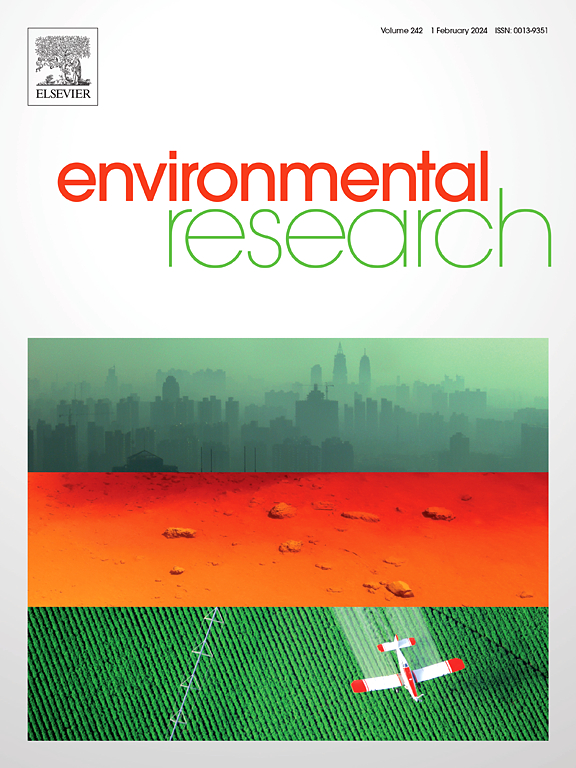微塑料污染对水稻生长、稻田土壤性质和温室气体排放的影响:一项全球荟萃分析
IF 7.7
2区 环境科学与生态学
Q1 ENVIRONMENTAL SCIENCES
引用次数: 0
摘要
微塑料污染已成为一个全球性的环境问题,对包括农业用地在内的各种生态系统构成威胁。对全球粮食安全至关重要的稻田尤其脆弱。然而,MP污染对这些系统中水稻生产、稻田土壤性质和温室气体(GHG)排放的具体影响尚不清楚。在这项研究中,我们通过综合全球40篇已发表的实验观察结果,进行了全面的荟萃分析,以确定MPs对水稻、稻田土壤特性和温室气体排放的影响,以及这些影响是否取决于MP特性和实验变量。研究发现,MPs可以通过诱导活性氧和抑制光合作用来减少水稻茎和根生物量。MPs通过丰富特定微生物种群或改变土壤养分循环,降低了土壤全氮(TN)、全磷(TP)、硝态氮(NO3−-N)、速效磷(AP)、铵态氮(NH4+-N)和有机碳(TOC)。此外,MPs刺激水稻土中的氮矿化、硝化和亚硝酸盐还原,从而增加一氧化二氮(N2O)的排放。此外,MP显著提高了水稻土细菌的ACE指数,表明其影响土壤微生物群落的机制可能是通过降低均匀度和放大优势种来实现的。值得注意的是,TOC对常规MPs的负响应强于对可生物降解MPs的负响应。大粒径MPs (>100 μm)对N2O排放有积极影响,但对TOC和土壤有机质(SOM)含量有不利影响。此外,AP、速效钾(AK)、TOC、溶解有机碳(DOC)和CH4排放与MP暴露时间有关。水稻总生物量、CH4和N2O排放、TOC、Shannon指数和Simpson指数均与MP浓度相关。综上所述,MPs可能对水稻土壤肥力和水稻生产造成威胁,并造成环境压力。本研究为水稻在MP污染下的绿色高效生产提供了重要参考。本文章由计算机程序翻译,如有差异,请以英文原文为准。

The effect of microplastic pollution on rice growth, paddy soil properties, and greenhouse gas emissions: A global meta-analysis
Microplastic (MP) pollution has emerged as a global environmental concern, posing threats to various ecosystems, including agricultural lands. Paddy fields, critical for global food security, are particularly vulnerable. However, the specific effects of MP contamination on rice production, paddy soil properties, and greenhouse gas (GHG) emissions in these systems remain unclear. In this study, we conducted a comprehensive meta-analysis by synthesizing experimental observations from 40 published articles worldwide to determine the impact of MPs on rice, paddy soil properties, and GHG emissions, and whether these impacts depend on MP characteristics and experimental variables. We found that MPs could reduce rice stem and root biomass by inducing reactive oxygen species and inhibiting photosynthesis. MPs decreased soil total nitrogen (TN), total phosphorus (TP), nitrate (NO3−-N), available phosphorus (AP), ammonium (NH4+-N), and organic carbon (TOC) by enriching specific microbial populations or altering soil nutrient cycling. Additionally, MPs stimulate nitrogen mineralization, nitrification, and nitrite reduction in paddy soils, thereby increasing nitrous oxide (N2O) emissions. Moreover, MP significantly increased the ACE index of paddy soil bacteria, suggesting a mechanism by which they affect soil microbial communities by reducing evenness and amplifying dominant species. Notably, the negative response of TOC to conventional MPs was stronger than that to biodegradable MPs. Large-sized MPs (>100 μm) had a positive effect on N2O emissions but had adverse effects on TOC and soil organic matter (SOM) content. Moreover, AP, available potassium (AK), TOC, dissolved organic carbon (DOC), and CH4 emissions were associated with the duration of MP exposure. The total biomass of rice, CH4 and N2O emissions, TOC, Shannon index, and Simpson index were related to MP concentration. In conclusion, our results indicate that MPs may threaten paddy soil fertility and rice production and exert environmental pressure. This study provides essential references for green and efficient rice production under MP pollution.
求助全文
通过发布文献求助,成功后即可免费获取论文全文。
去求助
来源期刊

Environmental Research
环境科学-公共卫生、环境卫生与职业卫生
CiteScore
12.60
自引率
8.40%
发文量
2480
审稿时长
4.7 months
期刊介绍:
The Environmental Research journal presents a broad range of interdisciplinary research, focused on addressing worldwide environmental concerns and featuring innovative findings. Our publication strives to explore relevant anthropogenic issues across various environmental sectors, showcasing practical applications in real-life settings.
 求助内容:
求助内容: 应助结果提醒方式:
应助结果提醒方式:


